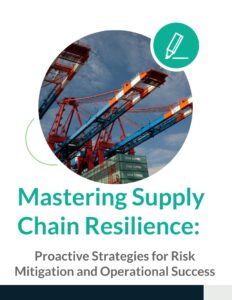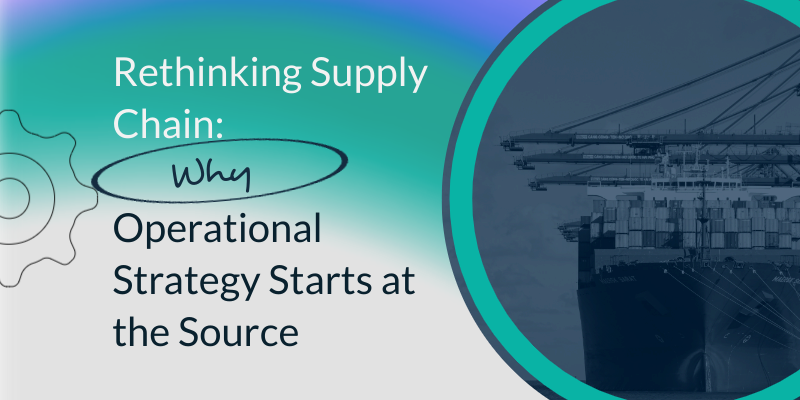In the past, supply chain management was largely viewed as a back-office function. It was the machinery behind the scenes—necessary, but not central to the strategic direction of the business. It kept things moving, costs down, and operations humming.
But that traditional view no longer holds water.
For decades, supply chain was measured by its ability to be the invisible workhorse—when everything flowed without disruption, it was considered successful. We would get done what needed to get done, usually manually tracking container whereabouts, inventory levels, price fluctuations, and product availability. Leaders focused on just-in-time models, lean inventories, and squeezing every ounce of efficiency from procurement, production, and delivery. It was a system built to serve stability requiring the professionals behind the screens and phones to work tirelessly to keep the businesses back office running. The expectation of things the businesses needs to just be available is no longer a reality.
The problem? The world is even less stable and unpredictable.
Fast forward to today: global pandemics, geopolitical unrest, regional conflicts, trade restrictions, climate-related disasters, labor shortages, and a surge in consumer expectations have laid bare just how brittle many supply chains actually are. What was once considered a “semi-well-oiled machine” is now exposed as a patchwork of manual processes, outdated systems, and siloed decision-making. Some of what contributes to the challanges today is that the industry as a whole has failed to respond to change with a proactive posture, continuing to operate their supply chains as a subcore component of the business.
It’s not just the big shocks that hurt. Even minor delays or stockouts now have cascading effects across departments, profit centers, and customer relationships. To resolve a disruption, companies are routinely absorbing unplanned costs: expedited shipping, excess inventory to prevent future shortages, or emergency vendor sourcing. These stopgaps aren’t just operational headaches—they’re bleeding margin, damaging reputations, and distracting leadership from long-term growth.
In this new era, supply chain has emerged as one of the most critical levers for business success—or failure. It’s not simply about moving products from A to B anymore. It’s about delivering value, mitigating risk, and aligning the heartbeat of operations with the pulse of your customers.
So if your organization still views supply chain as an operational afterthought, it’s time to reconsider. Because today, the companies that will thrive are the ones that treat supply chain as a core strategic asset—one capable of driving innovation, enabling agility, and sustaining growth in an unpredictable world.
The Changing Role of Supply Chain in Modern Business
Disruption has become a constant, and if I could make any promises to you the first would be that extreme challanges and disruptions are here to stay. From geopolitical shifts and labor shortages to raw material constraints accidental disasters, and climate events, businesses today face challenges that can no longer be “handled” with a patchwork of contingency plans.
Yet many organizations are still operating with outdated models that assume the supply chain is linear, controllable, and independent of the rest of the business. In some recent cases I’ve seen the wait until teh dust settles approach. That assumption is not just flawed—it’s dangerous.
The truth is this: supply chain touches everything. It impacts your customers, your employees, your profitability, your agility, and ultimately, your reputation. Treating it as a separate entity creates blind spots that are costing businesses more than they realize.
What’s Really at Stake
When supply chain is disconnected from business strategy, the consequences extend far beyond delays or rising costs. Businesses begin to experience systemic breakdowns:
- Overproduction or understocking
- Inaccurate demand forecasting
- Customer dissatisfaction
- Wasted spend and missed revenue
- Burnout in operations and frontline teams
And perhaps most critically, a lack of trust—internally and externally. Leaders no longer feel in control. Teams are forced into reactive mode. There’s a constant scramble to solve problems that shouldn’t exist in the first place. This is all happening ontop of the day-to-day operations causing leaders with already long todo lists and deadlines to meet to now have to shift their attention to firefighting mode.
This erosion of control and visibility doesn’t just create inefficiency. It stifles innovation and makes long-term growth nearly impossible.
Why the Traditional Approach No Longer Works
At the root of the issue is a fundamental misunderstanding: the idea that supply chain is a function to be optimized in isolation. In reality, supply chain is an ecosystem—a web of interdependencies where one weak link can send ripples across your entire organization.
That outdated, linear view leads to a fragmented landscape: disconnected systems, misaligned teams, and strategic plans that don’t reflect the operational reality on the ground. It’s not surprising that many executive teams are frustrated. They’re working hard, but the results are inconsistent.
The underlying problem? They’re optimizing the wrong thing.
The Shift Toward Strategic Supply Chain Management
When organizations stop treating supply chain as a cost center and start treating it as a strategic enabler, everything changes.
Supply chain leaders are no longer left out of strategic conversations—they’re central to them. Technology is no longer bolted on—it’s embedded into smarter, streamlined processes. Teams stop working in silos and start operating from a shared playbook that aligns execution with vision.
The result?
A business that doesn’t just survive disruption—but one that anticipates it, adapts to it, and uses it as a competitive advantage.
Where to Start: Building a More Strategic Supply Chain
This transformation doesn’t happen overnight. But it does start with a mindset shift—and a clear path forward. Here’s how to begin:
1. Make Visibility Your Baseline
You can’t manage what you can’t see. Real-time data, predictive analytics, and integrated platforms aren’t optional anymore—they’re the foundation. Visibility allows leaders to make proactive decisions and eliminates the guesswork that leads to operational chaos.
2. Rethink Supplier Relationships
Suppliers and partners are not just vendors—they’re extensions of your business. Strategic supply chains are built on trust, transparency, and collaboration. When partners are aligned on goals and outcomes, resilience becomes a shared responsibility.
3. Modernize Systems, Not Just Software
Too often, companies invest in new technology without rethinking their processes. This leads to digital Band-Aids over broken systems. The smarter move? Redesign your operations first, then layer in tools that support those streamlined workflows. Automation should simplify, not complicate.
4. Integrate Operations into Strategy
If your operations team is only brought in after strategy is set, you’re missing key insights that affect feasibility, scalability, and speed. True resilience happens when operations is part of shaping the strategy—not just executing it.
5. Shift the Narrative in the C-Suite
Supply chain is no longer a support function—it’s a strategic driver of growth, risk management, and customer experience. That narrative must change at the top if the business is going to evolve. Operational leaders should be empowered to lead—not just react.
What the Future Looks Like
The companies that will lead tomorrow are already making the shift today. They’re not chasing efficiency—they’re designing resilience. They’re not plugging gaps—they’re building alignment. And they’re not settling for old models—they’re redefining what operational excellence really looks like.
Supply chain is no longer the backend of the business—it’s the front line of value creation.
And when it’s treated with the strategic weight it deserves, the entire business benefits.







